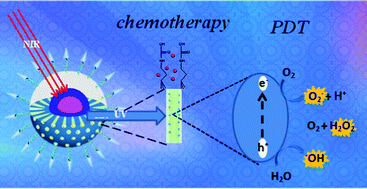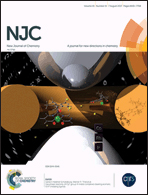DOX-UCNPs@mSiO2–TiO2 nanocomposites for near-infrared photocontrolled chemo/photodynamic therapy†
Abstract
Currently, incorporating multiple therapeutic functions into one nanostructure has attracted more and more attention for the development of efficient anticancer agents. In this study, a uniform core–shell UCNPs@mSiO2 nanocomposite was prepared as the carrier to develop the NIR light-controlled chemotherapy associated with photodynamic therapy (PDT). In view of the novel UV emission, the semiconductor photosensitizer TiO2 was exploited due to its high efficiency and chemical stability. The host modification method was used to integrate TiO2 doping and mesoporous structure, which can store anticancer drug molecules (doxorubicin, DOX). To improve the utilization of emission, a photolabile o-nitrobenzyl derivative was incorporated to form a sensitive linker (NB linker) as a “gate” to make sure the few leak. Upon NIR irradiation, the UV emission can not only excite TiO2 to produce reactive oxygen species (ROS), but also induce the breaking of NB linker as well as drug release. The NIR-triggered performances were further demonstrated by the cell experiment using HeLa cells as the model cancer cell. The synergistic effect of chemotherapy and PDT induces enhanced cytotoxicity, which is more powerful than their simple effects added together. Therefore, the novel NIR light-controlled double-therapeutic nanocomposite should be a potential candidate for anticancer agents.



 Please wait while we load your content...
Please wait while we load your content...